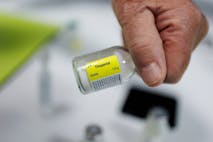
Vietnamese Catholics widen support for pregnant mothers
Angeline Tan
·
International·By Bridget Sielicki
New report shows negative impacts of euthanasia on palliative care in Canada
A recent report in the journal Palliative Medicine reveals that the rise of euthanasia and assisted suicide in Canada has had a very negative impact on the palliative treatment given to the sick and dying. An article in BioEdge details the main takeaways from the study — and the results are unsurprising to those who have long warned of potential pitfalls.
Canada’s Medical Assistance in Dying (MAiD) — the government’s blanket term for assisted suicide and euthanasia — was legalized in 2016, creating many problems for those within the palliative care community. To fully document the impact MAiD has had, the study authors surveyed 23 palliative care providers (13 physicians and 10 nurses) in Southern Ontario, “aim[ing] to explore the experience of frontline palliative care providers about the impact of Medical Assistance in Dying on palliative care practice.”
Conflicts of interest
The Mayo Clinic defines palliative care as “specialized medical care that focuses on providing patients relief from pain and other symptoms of a serious illness, no matter the diagnosis or stage of disease.” By its very nature, palliative care is meant to provide comfort and improve the quality of life for patients. Unsurprisingly, all of those surveyed acknowledged a conflict of interest in providing proper palliative care while also dealing with MAiD, as maintaining eligibility for assisted dying meant that it was necessary to withhold medication from those who needed it most. “Maintaining lucidity and eligibility for assisted death, by avoiding sedative medications, took priority over achieving good symptom control for some patients,” they wrote. Both patients and their providers found this difficult.
The medical providers also revealed that since MAiD’s implementation, they have felt pressure to discuss the option of assisted suicide or euthanasia with their patients. This can make some patients and their families nervous, feeling like death is the only option. Additionally, those providers who are morally opposed to MAiD now find it more difficult to have frank conversations with their patients.
Emotional toll on providers
Article continues below
Dear Reader,
In 2026, Live Action is heading straight where the battle is fiercest: college campuses.
We have a bold initiative to establish 100 Live Action campus chapters within the next year, and your partnership will make it a success!
Your support today will help train and equip young leaders, bring Live Action’s educational content into academic environments, host on-campus events and debates, and empower students to challenge the pro-abortion status quo with truth and compassion.
Invest in pro-life grassroots outreach and cultural formation with your DOUBLED year-end gift!
Another side effect is one that is rarely discussed: the emotional toll that these deaths play on medical providers. Most medical professionals enter the field because they want to care for their patients, not kill them. The BioEdge article described this, saying, “MAiD has a significant emotional and personal impact on PC providers. Many of the clinicians described a large emotional toll created by exposure to Medical Assistance in Dying.” This response coincides with the experience of many others in the medical community who report being emotionally traumatized after actively participating in the death of another.
Rerouted resources
Lastly, the report revealed that palliative care providers believe that resources that would otherwise go to them are now being used for MAiD procedures, with money that could be used to provide comfort and quality care for patients now being used to end their lives instead.
As Live Action News has previously noted, palliative treatment offers suffering patients real care, not death. Many palliative care providers enter the field because they want to offer compassionate care to society’s most vulnerable citizens. As this study shows, asking them to instead participate in the killing of patients leads to widespread repercussions.
“Like” Live Action News on Facebook for more pro-life news and commentary!
Live Action News is pro-life news and commentary from a pro-life perspective.
Contact editor@liveaction.org for questions, corrections, or if you are seeking permission to reprint any Live Action News content.
Guest Articles: To submit a guest article to Live Action News, email editor@liveaction.org with an attached Word document of 800-1000 words. Please also attach any photos relevant to your submission if applicable. If your submission is accepted for publication, you will be notified within three weeks. Guest articles are not compensated (see our Open License Agreement). Thank you for your interest in Live Action News!

Angeline Tan
·
International
Angeline Tan
·
Politics
Stefano Gennarini, J.D. and Kelly Heilman, J.D.
·
Politics
Bridget Sielicki
·
Politics
Angeline Tan
·
Politics
Right to Life UK
·
Politics
Bridget Sielicki
·
Politics
Bridget Sielicki
·
International
Bridget Sielicki
·
International
Bridget Sielicki
·
International
Bridget Sielicki
·